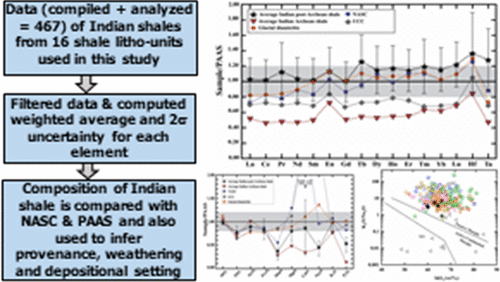当前位置:
X-MOL 学术
›
ACS Earth Space Chem.
›
论文详情
Our official English website, www.x-mol.net, welcomes your
feedback! (Note: you will need to create a separate account there.)
Major and Trace Element Characteristics of the Average Indian Post-Archean Shale: Implications for Provenance, Weathering, and Depositional Environment
ACS Earth and Space Chemistry ( IF 2.9 ) Pub Date : 2021-05-05 , DOI: 10.1021/acsearthspacechem.1c00030 Esha Ray 1 , Debajyoti Paul 1
ACS Earth and Space Chemistry ( IF 2.9 ) Pub Date : 2021-05-05 , DOI: 10.1021/acsearthspacechem.1c00030 Esha Ray 1 , Debajyoti Paul 1
Affiliation

|
We estimate the average chemical composition of Indian post-Archean Shale (IPAS) and conclude that it is comparable to that of global shale standards: post-Archean Australian Shale (PAAS) and North American Shale Composite (NASC). These shales are widely considered as continent wide, average compositional representatives of the post-Archean upper continental crust (UCC). Our IPAS estimate includes compiled literature (n = 444) and newly obtained (23 samples from 16 shale litho-units) data. The average IPAS has a composition comparable to that of the average, fine-grained matrix of glacial diamictites (tillite). Compared to a global model of UCC, notable differences in some elements are observed. Our estimated IPAS composition is more comparable to PAAS than NASC, with the latter being distinctly different likely due to having been recently glaciated and significantly resurfaced by the last glaciation, resulting in new shale production starting only about 12,000 years ago. Comparisons between the post-Archean and Archean Indian shales finds the latter with lower ΣREE; smaller negative Eu anomaly; lower Th/Sc, Th/Cr, and Th/U ratios; and higher Sc, V, Cr, Cu, and Zn contents. These findings suggest a greater contribution from mafic sources to Archean shales. A higher chemical index of alteration (CIA = 80 ± 2) for Indian Archean shales, relative to the post-Archean shales (72 ± 3) and UCC (59–65), suggests more intense weathering in the pCO2-rich Archean time. Indian shales were mostly deposited in plate interiors or intracratonic basins along a passive margin based on tectonic discrimination diagrams. Our IPAS estimate reflects the average composition of Indian sedimentary rocks and serves as the first step toward estimating the chemical composition of Indian UCC.
中文翻译:

印度平均后Archean页岩的主要和微量元素特征:对物源,风化和沉积环境的影响
我们估算了印度Archean后页岩(IPAS)的平均化学成分,得出的结论与全球页岩标准相当:Archean澳大利亚页岩(PAAS)和北美页岩复合材料(NASC)。这些页岩被广泛认为是后Archean上大陆壳(UCC)的整个大陆的平均成分代表。我们的IPAS估算包括已汇编的文献(n= 444)和新获得的数据(来自16个页岩岩石单元的23个样本)。平均IPAS的成分与冰层铁钛矿(tillite)的平均细粒基质相当。与UCC的全球模型相比,在某些要素上存在显着差异。我们估计的IPAS组成与PAAS相比要比NASC更可比,而NASC则明显不同,这可能是由于最近被冰川化和最后一次冰川作用使表层明显地重新浮出水面,导致了大约12,000年前才开始生产新的页岩。比较后阿奇安时代和太古时代的印度页岩,发现后者的REE值较低。较小的负Eu异常;较低的Th / Sc,Th / Cr和Th / U比;以及更高的Sc,V,Cr,Cu和Zn含量。这些发现表明,镁铁质来源对太古宙页岩的贡献更大。p CO 2-丰富的太古宙时间。根据构造判别图,印度页岩大多沿被动边缘沉积在板块内部或克拉通盆地内。我们的IPAS估算值反映了印度沉积岩的平均成分,是估算印度UCC化学成分的第一步。
更新日期:2021-05-20
中文翻译:

印度平均后Archean页岩的主要和微量元素特征:对物源,风化和沉积环境的影响
我们估算了印度Archean后页岩(IPAS)的平均化学成分,得出的结论与全球页岩标准相当:Archean澳大利亚页岩(PAAS)和北美页岩复合材料(NASC)。这些页岩被广泛认为是后Archean上大陆壳(UCC)的整个大陆的平均成分代表。我们的IPAS估算包括已汇编的文献(n= 444)和新获得的数据(来自16个页岩岩石单元的23个样本)。平均IPAS的成分与冰层铁钛矿(tillite)的平均细粒基质相当。与UCC的全球模型相比,在某些要素上存在显着差异。我们估计的IPAS组成与PAAS相比要比NASC更可比,而NASC则明显不同,这可能是由于最近被冰川化和最后一次冰川作用使表层明显地重新浮出水面,导致了大约12,000年前才开始生产新的页岩。比较后阿奇安时代和太古时代的印度页岩,发现后者的REE值较低。较小的负Eu异常;较低的Th / Sc,Th / Cr和Th / U比;以及更高的Sc,V,Cr,Cu和Zn含量。这些发现表明,镁铁质来源对太古宙页岩的贡献更大。p CO 2-丰富的太古宙时间。根据构造判别图,印度页岩大多沿被动边缘沉积在板块内部或克拉通盆地内。我们的IPAS估算值反映了印度沉积岩的平均成分,是估算印度UCC化学成分的第一步。











































 京公网安备 11010802027423号
京公网安备 11010802027423号